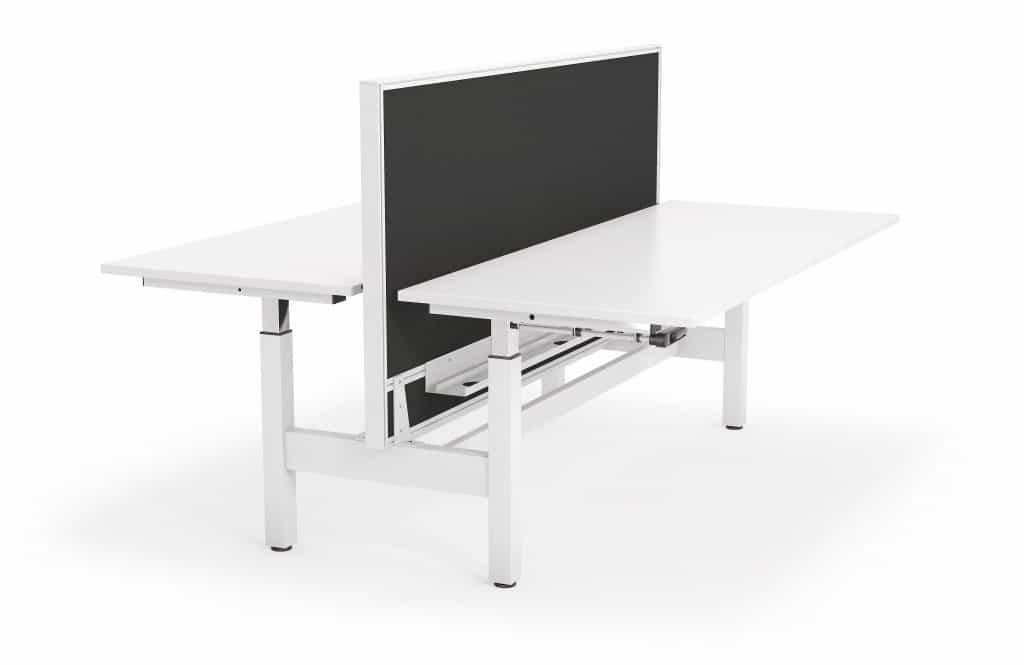Across Australia (and much of the world), people are now standing to perform many of the tasks that they used to complete sitting down. This is becoming common practice in receptions, the bullpen and even in meeting rooms. There is now an even larger variety of adjustable height and standing desks available, which have been proven to be good for us in a number of ways.

How are these desks “good” for us?
1. They reduce back pain
Back pain is a common complaint among office workers who sit all day. Sitting in an office chair for long periods of time wreaks havoc on your lower back, joints and muscles because your body wasn’t made to sit for five to six hours a day. Your body was made to move.
By standing periodically throughout the day, you can relieve back and neck pain. According to a 2018 study, employees who used a sit-stand workstation or desk at the office experienced a 50 per cent decrease in lower back pain compared to a group that didn’t participate in the study.
2. They help you lose or maintain weight
You gain weight by taking in more calories than you burn. While exercise is the most effective way to burn calories and lose weight, choosing to stand instead of sit at the office is also beneficial.
Prolonged periods of sitting promote fat accumulation by slowing down your metabolism. Sitting burns around 50-70 calories per hour while standing burns 85-110 calories per hour. This caloric difference, when added to a month of standing instead of sitting, helps you maintain your weight and avoid the risks of obesity.
3. They help prevent serious conditions
An increase in blood sugar levels is natural after a meal but individuals with large spikes in blood sugar have a higher risk of becoming diabetic. This is because our bodies lose their ability to efficiently use blood sugar when we remain sedentary for too long.
Sit-stand office workstations and desks allow you to stand up and move around while you work. Alternating between standing and sitting will lower your blood sugar levels and cholesterol, decreasing your risk of diabetes and cardiovascular diseases.
4. They help prevent serious conditions
A study (by the Institute for Human Development in Berlin, Germany) has even shown that standing at your desk can even make you smarter!
Basically, the study got people to walk on a treadmill whilst performing some basic cognitive tasks to see if they would think better while walking. The conclusion – they sure did. And haven’t we all experienced a light bulb moment just getting up from our desks? Or felt re-energised about the task at hand from simply going to the printer?
What about in meetings?
And when it comes to meetings, people find that standing makes them more attentive, more energised and less likely to waste words. Some managers and supervisors have found that, in the past, when they would book a meeting room (with chairs) for half an hour, the whole timeframe would be used. Now, a meeting (without chairs) can be over and done within 10 minutes.
Tips on using the standing desk properly
1. Adjust it to a comfortable height
Your body naturally settles into a neutral position with a slouched or an arched back. When you’re standing, this position can strain your muscles and bones, causing discomfort and pain. When you set up your office standing desk, adjust its height so that you can easily align your head, neck and spine. Your head should be slightly back, your spine should have an ‘S’ curve and your hips should be straight. Your monitor should also be at eye level to prevent your eyes from getting strained.
2. Ease into using the desk slowly
Give your body time to adjust to using the standing desk. Going from sitting for eight hours to standing for long periods can be taxing on your back so be kind to yourself. Start by standing for thirty minutes to an hour a few times a day. Then work up to blocks of two hours, then three, four and so forth.
3. Vary standing with sitting and walking
Standing still is just as unhealthy as sitting still. Change your position, shift your weight and take short walking breaks every 30 minutes or so. You can use this time to walk to a colleague’s desk to talk about a certain task, refilling your water or doing a few squats at your desk. You can also sit down for around 15 minutes to relax your bones and muscles.
Are there any downsides?
For some workers, however, the idea of standing for 8 hours per day can seem like downright torture. A good example of this is the ticket barrier attendants at Sydney train stations – whilst management believes that removing chairs has improved customer service, commuters haven’t really noticed much difference and workers actually note that it’s harder to maintain their concentration.
What are our conclusions?
It is for this reason that standing desks are unlikely to permeate workplaces as quickly as it was once thought. Whilst those in office professions (whereby they spend hours at a time in front of a computer) will certainly see improvements and benefits from implementing such a policy, it seems that those in more retail professions (whereby the spend periods of time dormant) will prefer to sit.

At the end of the day, you need to consider the time of industry in which you operate and the type of people that you employ – more often than not, you will find that your workplace will benefit from adjustable height or standing desks. Why not implement them in your workplace for a trial run (perhaps only for those employees who want to try them out)?


